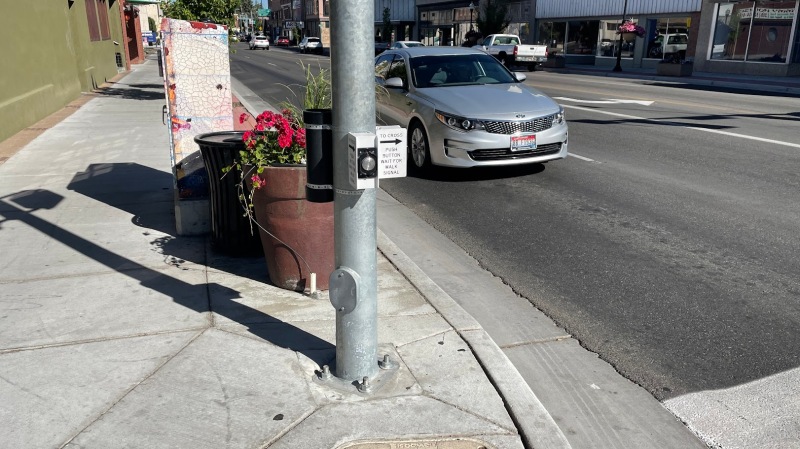Even though the Americans with Disabilities Act was passed more than 40 years ago, we have never had official accessibility standards tailored to things like sidewalks, curb ramp, and pedestrian push buttons.
That’s about to change.

The federal government posted notice that final action will be taken in Spring 2022 to make the Public Right-of-Way Accessibility Guidelines the official standards for streets. While this should improve conditions, it will remain a challenge to ensure that streets will become more accessible and safer if agencies are slow to act.
Don’t beat yourself up if you’ve never heard of these guidelines. Known to insiders as PROWAG, they are a relatively obscure set of technical specifications to help designers create accessible routes along and across public streets.
Professional wonks like me routinely use PROWAG to help make streets accessible and safe for people with disabilities. The problem is, PROWAG has sat in draft form within the bowels of the federal government since the mid-2000s. It has not been open for public comment since 2013.
The United States Access Board develops them as guidelines, but it takes official action by the federal government to turn them into federal standards. That’s what this action would finally do.
PROWAG provides a more relevant application of accessibility requirements to street settings than the current standards known as the ADA Accessibility Guidelines, commonly called ADAAG.
ADAAG is more applicable to design features within building and recreational facilities, like fishing piers and play areas. Because of that, ADAAG contains few specifics on street-based accessibility needs.
For example, ADAAG classifies a pedestrian push button as an “operable part.” Operable parts include many things people need to reach, such as light switches, thermostats, automatic door controls, and gas pump handles. If these features are not within reach to, for instance, a person in a wheelchair, or findable to a person who is blind, then it constitutes denial of equal access.
If someone designing a street seeks to find out how to make a push button accessible, what ADAAG says about operable parts may not contain enough information for designers to ensure the many features at a street corner are taken into account. ADAAG doesn’t address where that push button needs to be located in relation to a curb ramp. PROWAG does.
Some entity took the time to add these curb cuts, but couldn’t be bothered to actually connect the sidewalks.
— Erik Landfried (@DurhamComplete) November 28, 2021
(This is a picture of downtown Durham, by the way. Let’s fix the basics, please.) pic.twitter.com/v8jy3ZC0fF
I became familiar with PROWAG in 2004 while working on a countywide inventory of sidewalk and curb ramp conditions for Boise and the five other cities in Ada County, Idaho. The agency I worked for, Ada County Highway District (ACHD), had not previously focused on detailed design elements of their streets to make them safer and accessible for people with disabilities. Needless to say, it was a big effort.
We decided to inventory our system through the lens of PROWAG standards, since it was assumed they would soon be finalized at the federal level. After all, if we started building curb ramps in 2004 in accordance with draft PROWAG, then anything built after that point would be compliant whenever PROWAG became the standard. I left the agency in 2008 and, unfortunately, that mindset departed with me.
Just last year, a project in downtown Boise resulted in work zone signs placed between the curb and sidewalk on a street ACHD manages. The signs blocked sidewalk access to people with disabilities using a designated accessible parking space.
A Boise resident emailed ACHD about it, citing one of PROWAG’s conditions: “The sidewalk adjacent to the accessible parking spaces should be free of signs, street furniture, and other obstructions.”
The agency’s attorney responded that their “policy is to comply with the ADA and ADAAG…PROWAG is not the law.” They cloaked themselves in PROWAG being only a draft document to justify blocking access with construction signs.
This is why making PROWAG the official standard represents a long-awaited shift in the tectonic plates of ADA policy. While some cities and State DOTs have already incorporated PROWAG into their policies and design standards, many have not. This is the case despite the Federal Highway Administration (FHWA) citing PROWAG as a best practice soon after it was published. ACHD is now doing so, too.
But once PROWAG becomes the standard, history tells us it won’t be easy to get agencies to comply with it. Those that have yet to incorporate it into their policies and design drawings will take their time doing so. Street inventories of existing sidewalks, curb ramps, and push buttons that didn’t incorporate PROWAG into the assessment will have to be redone.
Making it harder is the fact that the Federal Highway Administration does not actively review the design of federal-aid projects for ADA compliance, choosing only to respond when a formal complaint is filed.
All of this means that, even when made the standard, the public will be reliant on pressuring many federal, local, and state agencies to make PROWAG their own. Now you know what you have to do.






